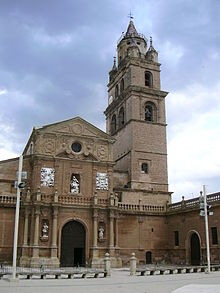Diocese of Calahorra y La Calzada-Logroño
|
Diocese of Calahorra y La Calzada-Logroño
|
|
| Basic data | |
|---|---|
| Country | Spain |
| Metropolitan bishopric | Archdiocese of Pamplona y Tudela |
| Diocesan bishop | Carlos Manuel Escribano Subías |
| surface | 5,033 km² |
| Parishes | 253 (December 31, 2013 / AP2014 ) |
| Residents | 323,609 ( 12/31/2013 / AP2014 ) |
| Catholics | 291.100 ( 12/31/2013 / AP2014 ) |
| proportion of | 90% |
| Diocesan priest | 212 (December 31, 2013 / AP2014 ) |
| Religious priest | 68 ( 12/31/2013 / AP2014 ) |
| Catholics per priest | 1,040 |
| Friars | 175 (December 31, 2013 / AP2014 ) |
| Religious sisters | 600 ( 12/31/2013 / AP2014 ) |
| rite | Roman rite |
| Liturgical language | Spanish |
| cathedral | Catedral de El Salvador y Santa María in Santo Domingo de la Calzada Catedral de la Asunción de Nuestra Señora in Calahorra |
| Co-cathedral | Concatedral de Santa María de la Redonda in Logroño |
| Website | www.iglesiaenlarioja.org |
| Ecclesiastical province | |

|
|
The diocese of Calahorra y La Calzada-Logroño ( lat. : Dioecesis Calaguritanus et Calceatensis-Lucroniensis ) is in Spain situated Roman Catholic diocese , based in Calahorra .
history
The Diocese of Calahorra y La Calzada-Logroño was established in the 5th century as the Diocese of Calahorra and subordinated to the Archdiocese of Tarragona as a suffragan . It is first reliably attested just after 450, when Bishop Silvanus had a dispute with the Metropolitan of Tarragona. In the Visigothic era, the bishops of Calahorra participated in various imperial synods. Then around 714 the Moors occupied Calahorra, for whose diocese no names of bishops have survived for the 8th century. Shortly after 800 there are signs of the bishops of Calahorra, who at that time had found refuge in Oviedo . After the Christian reconquest of the northern Spanish city of Nájera by King Ordoño II (923), some of the newly established bishops there claimed to be the successors in the diocese of Calahorra. They still officiated in Nájera when King García III. of Navarra had brought Calahorra back under Christian suzerainty in 1045.
When King Alfonso VI. of Castile-León was in government in the second half of the 11th and the beginning of the 12th century, the diocese of Calahorra rose to become one of the largest and financially wealthiest dioceses in Spain; about 1093 the former territory of Armentia was added to him. Because Nájera was more central than Calahorra, the bishops took their seat there until the end of the 12th century, which they then moved to Santo Domingo de la Calzada . As a result, there were disputes between the canons of Calahorra and those of La Calzada. A resulting schism within the diocese was ended in 1221. Since 1235 the diocese was called Calahorra y La Calzada , in 1318 it was given by Pope John XXII. Subordinated to the new Archdiocese of Saragossa as a suffragan.
In 1574 the Diocese of Calahorra y La Calzada was subordinated to the Archdiocese of Burgos . On September 8, 1861, there were parts of its territory to establish the diocese of Vitoria . Another assignment of territory took place on November 2, 1949 to establish the Diocese of Bilbao . The diocese of Calahorra y La Calzada was subordinated to the Archdiocese of Pamplona y Tudela as a suffragan on August 11, 1956 . On March 9, 1959, it was renamed the Diocese of Calahorra y La Calzada-Logroño .
See also
Web links
- Official Website (Spanish)
- Entry for the Diocese of Calahorra y La Calzada-Logroño on catholic-hierarchy.org
Remarks
- ↑ MI Falcón: Calahorra . In: Lexicon of the Middle Ages (LexMA). Volume 2, Artemis & Winkler, Munich / Zurich 1983, ISBN 3-7608-8902-6 , Sp. 1385 f.


